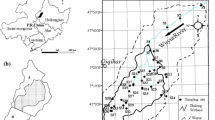Abstract
Pb and Cd concentrations in the habitat and preys of the red-crowned crane (i.e., reed rhizomes and three typical aquatic animal families (Perccottus glehni Dybowski, Carassius auratus Linnaeus, and Viviparidae)) were analyzed to examine the impact of these hazards on red-crowned cranes in northeastern China. Results indicated that Pb and Cd concentrations in the preys of the red-crowned cranes were elevated via food chain. Most of the detected Pb and Cd contents in the sediments were above the natural background level, ranging from 9.85 to 129.72 ppm and 1.23 to 10.63 ppm (dry weight), respectively. Cd geo-accumulation index at all sites were larger than 3, even reached 5.22, suggesting serious pollution in this region. Three common water animal families were detected to contain heavy metals, following the order of increasing concentrations: primary consumers (i.e., Viviparidae and Carassius auratus Linnaeus) < secondary consumers (i.e., Perccottus glehni Dybowski). Pb and Cd concentrations in the buffer zone are significantly higher than in the core area and being elevated in the food chain. The molten feathers of the red-crowned cranes showed the highest toxic metal concentrations of Pb (2.09 to 5.81 ppm) and Cd (1.42 to 3.06 ppm) compared with the feces produced by cranes and residual eggshell left by water fowls. Exceptionally high Pb and Cd concentrations in the cranes and their preys were thought to be associated with their habitat.






Similar content being viewed by others
References
Agah H, Leermakers M, Elskens M, Mohamad Rez Fatemi S, Baeyens W (2009) Accumulation of trace metals in the muscle and liver tissues of five fish species from the Persian Gulf. Environ Monit Assess 157:499–514
BirdLife International. 2012. Grus monacha: IUCN 2012. IUCN Red List of Threatened Species. Version 2012. 4. http://www.birdlife.org/datazone/speciesfactsheet. Accessed 15 May 2013
Burger J (2002) Food chain differences affect heavy metals in bird eggs in Barnegat Bay, New Jersey. Environ Res Sect A 90:33–39
Burger J, Gochfeld M (1993) Lead and cadmium accumulation in eggs and edgling seabirds in the New York Bight. Environ Toxicol Chemestry 12:261–267
Burger J, Gochfeld M (1997) Risk, mercury levels, and birds: relating adverse laboratory effects to field biomonitoring. Environ Res 75:160–172
Burger J, Gochfeld M, Jeitner C, Snigaroff D, Snigaroff D, Stamm T, Volz C (2008) Assessment of metals in down feathers of female common eiders and their eggs from Aleutians: arsenic, cadmium, chromium, lead, manganese, mercury, and selenium. Environ. Monit. Assess. 143(1–3):247–256
Canli M, Ay O, Kalay M (1998) Levels of heavy metals (Cd, Pb, Cu, Cr and Ni) in tissue of Cyprinus carpio, Barbus capito and Chondrostoma regium from the Seyhan River, Turkey. Turk J Zool 22:149–157
Dauwea T, Bervoetsb L, Pinxtena R, Blustb R, Eens M (2003) Variation of heavy metals within and among feathers of birds of prey: effects of molt and external contamination. Environ Pollut 124:429–436
Ebrahimpour M, Mushrifah I (2008) Heavy metal concentrations in water and sediments in Tasik Chini, a Freshwater Lake, Malaysia. Environ Monit Assess 141:297–307
Fasola M, Movalli PA, Gandini C (1998) Heavy metal, organochlorine pesticide, and PCB residues in eggs and feathers of herons breeding in Northern Italy. Arch Environ Contam Toxicol 34:87–93
Fisk A, deWit C, Wayland M, Kuzyk ZZ, Burgess N, Lethcer R, Branue B, Norstrom R, Blum SP, Sandau C, Lie E, Larsen HJS, Skaare JU (2005) Assessment of toxicological significance of anthropogenic contaminants in Caniadia Artic wildlife. Sci Total Environ 351–352:57–93
Fleischer M, Sarofim AF, Fassett DW, Hammond P, Shacklette HT, Nisbet ICT, Epstein S (1974) Environmental impact of cadmium. Environ Health Perspect 5:253
Hansan SA, Fariduddin Q, Ali B (2009) Cadmium: toxicity and tolerance in plants. J Environ Biol 20(2):165–174
Harris J (2008) Cranes respond to climate change. ICF Bugle 34(1–3):14–15
Hughes MK, Lepp NW, Phipps DA (1980) Aerial heavy metal pollution and terrestrial ecosystems. Adv Ecol Res 11:217
Joint FAO/WHO Food Standards Programme. (1990). Guideline levels for cadmium and lead in food. Codex committee of food additives and contamination, 22nd session, Haugue, March 1924
Kabata-Pendias A, Pendias H (2001) Trace Elements in Soils and Plants, 3rd edn. CRC Press, Boca Raton
Koller LD (1980) Immunotoxicology of heavy metals. Int J Immunopharmacol 2:269–279
Malik N, Biswas AK, Qureshi TA, Borana K, Virha R (2010) Bioaccumulation of heavy metals in fish tissues of a freshwater lake of Bhopal. Environ Monit Assess 160:267–276
Martínez-Villegas N, Flores-Vélez LM, Domínguez O (2004) Sorption of lead in soil as a function of ph: a study case in México. Chemosphere 57:1537–1542
Muller G (1969) Index of geo-accumulation in sediments of the Rhine River. Geo J 2(3):108–118
Nsikak UB, Joseph PE, Akan BW, David EB (2007) Mercury accumulation in fishes from tropical aquatic ecosystems in the Niger Delta, Nigeria. Curr Sci 92(6):781–785
Pain DJ, Meharg AA, Ferrer M, Taggart M, Penteriani P (2005) Lead concentrations in bones and feathers of the globally threatened Spanish imperial eagle. Biol Conserv 121:603–610
Sekabira K, Oryem Origa H, Basamba TA, Mutumba G, Kakudidi E (2010) Assessment of heavy metal pollution in the urban stream sediments and its tributaries. Int J Environ Sci Tech 7(3):435–446
Sorvari J, Eeva T (2010) Pollution diminishes intra-specific aggressiveness between wood ant colonies. Sci Total Environ 408:3180–3192
Tabari S, Soheil S, Saravi S, Bandany GA, Dehghan A, Shokrzadeh M (2010) Heavy metals (Zn, Pb, Cd and Cr) in fish, water and sediments sampled form Southern Caspian Sea, Iran. Toxicol Ind Health 26:649–656
Tang J, Li N, Li H, Bian J, Li Z, Cui Y (2012) Flux and source appointment of heavy metals from atmospheric dry and wet deposition in Daqing City, China. J Jilin Univ (Earth Science Edition) 42:507–513, in Chinese
Teraoka H, Kumagai Y, Iwai H, Haraguchi K, Ohba T, Nakai K, Satoh H, Sakamoto M, Momose K, Masatomi H, Hiraga T (2007) Heavy metal contamination status of Japanese cranes (Grus japonensis) in East Hokkaido, Japan-Extensive Mercury Pollution. Environ Toxicol Chem 26:307–312
USEPA (1996) Method. 3050B-Acid Digestion of Sediments, Sludges, and Soils. US Environmental Protection Agency, USA
Viklander M (1998) Particle size distribution and metal content in street sediments. J Environ Eng 124:761–766
Zhang Z, Song X, Wang Q (2012) Cd and Pb contents in soil, plants, and grasshoppers along a pollution gradient in Huludao City, northeast China. Biol Trace Elem Res 145:403–410
Zuo P, Zhao S, Zhao X, Teng H, Geng J, Gao X (2010) Distribution characteristics of heavy metals in surface sediments in original salt marshes in Yancheng, Jiangsu Province, China. Marine Sci Bul 29:372–377 (in Chinese)
Acknowledgments
We would like to thank the anonymous reviewers for their constructive advice for this manuscript. This research was funded by the National Youth Science Foundation of China (grant no. 41071022), School of supporting youth's academic backbone project in Heilongjiang province of China (grant no. 1253G063), Heilongjiang Province Environmental Geography College Key Laboratory of remote sensing monitoring project, and Program for Young Teachers Scientific Research in Qiqihar University (grant no. 2012K-Z10). We extend appreciation to Wang Wenfeng of Zhalong National Nature Reserve for his suggestions and help for field sample collection.
Author information
Authors and Affiliations
Corresponding author
Rights and permissions
About this article
Cite this article
Luo, J., Yin, X., Ya, Y. et al. Pb and Cd Bioaccumulations in the Habitat and Preys of Red-Crowned Cranes (Grus japonensis) in Zhalong Wetland, Northeastern China. Biol Trace Elem Res 156, 134–143 (2013). https://doi.org/10.1007/s12011-013-9837-y
Received:
Accepted:
Published:
Issue Date:
DOI: https://doi.org/10.1007/s12011-013-9837-y




